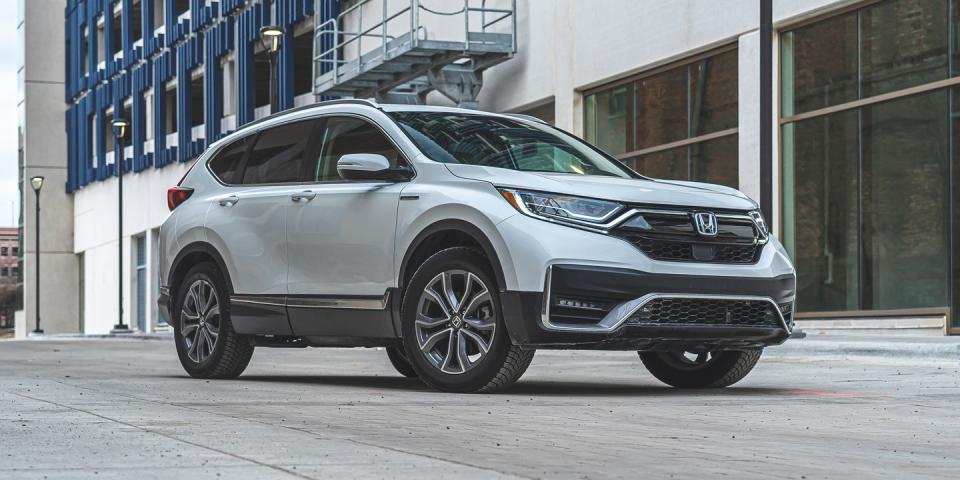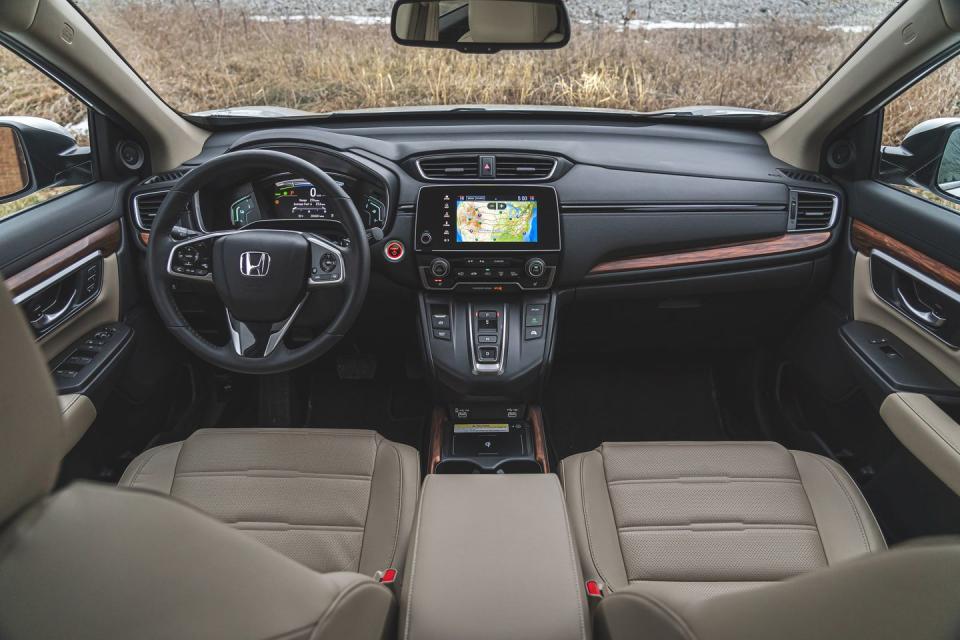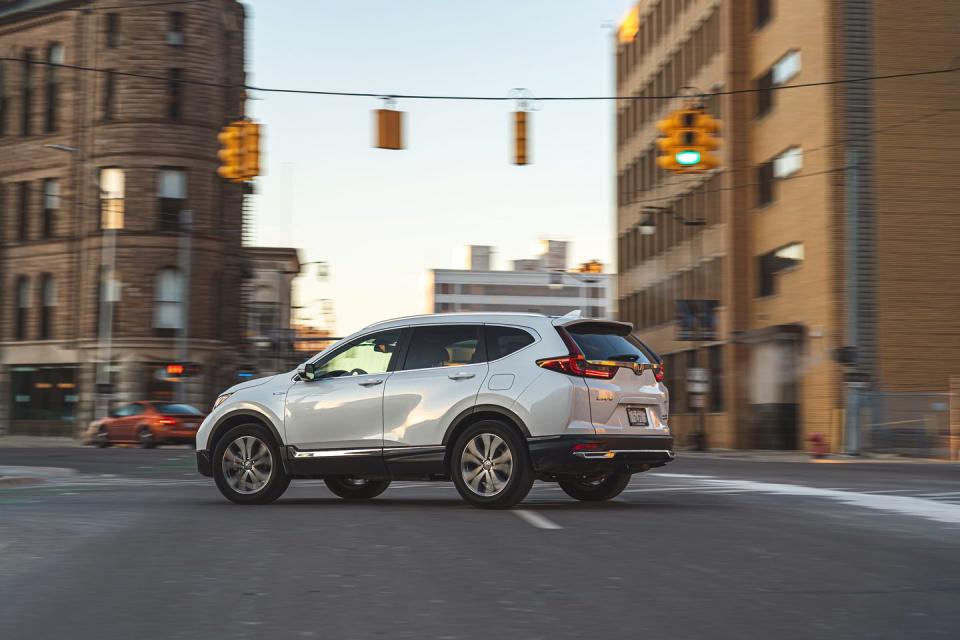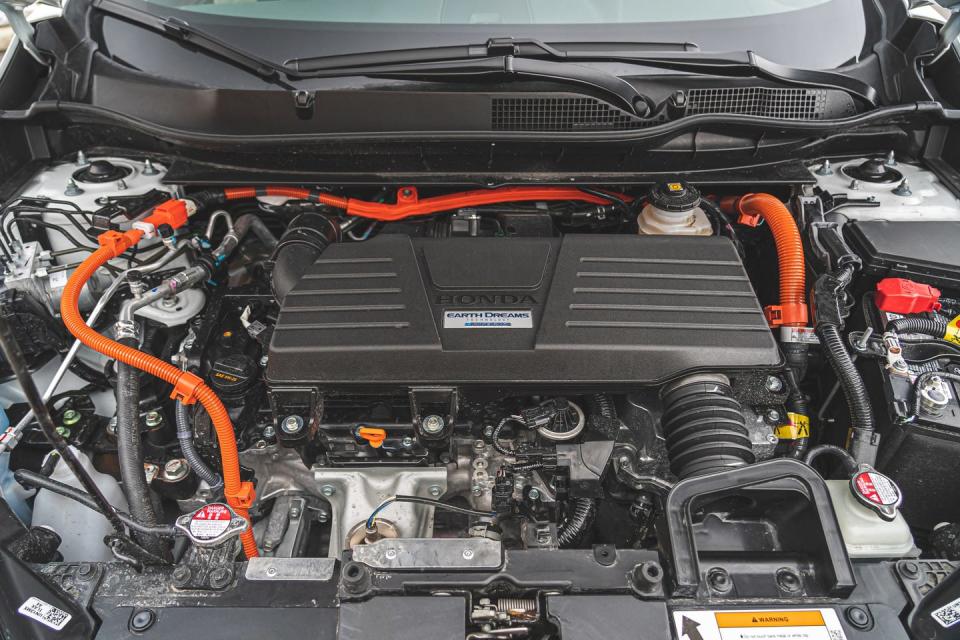A 2021 Honda CR-V Hybrid Sidles into Our Long-Term Fleet

Introduction
We invited a 2021 Honda CR-V to endure our 40,000-mile test to spend some quality time with Honda's bestseller and the fifth-bestselling vehicle in the United States. We chose the hybrid version because it's new to the lineup and because we liked the 212-hp fuel-sipping powertrain in the Accord hybrid. In the CR-V, the system boosts fuel economy and performance, making it the choice for buyers who want fuel efficiency and power. Those customers will have to shell out for it, however, since the CR-V hybrid sits at the top of the range. In addition to shaking down the hybrid system and seeing if it can deliver the promised fuel economy, we're hoping that this compact crossover—the brand's first with hybrid power to make it to the United States—will give us a glimpse at the future of Honda, which will soon phase out gas-only powertrains in Europe.
We ordered a top-of-the-line Touring model loaded with leather seats (heated up front), navigation, wireless phone charging, Android Auto and Apple CarPlay integration, a nine-speaker audio system, a liftgate that opens when you wave your leg under the bumper, proximity key entry, remote start, the Honda Sensing suite of driver-assistance features, and more. Our $37,920 example has but one option: white paint for $395. Perhaps it's because all of southeast Michigan is currently covered in two feet of snow or because half the vehicles in the grocery-store parking lot are also painted in America's favorite automotive hue (and shaped like tall boxes), but the CR-V blends in a little too well with its surroundings. We wouldn't call the color choice regrettable but maybe a bit forgettable.

Inside, Honda's inoffensive design, easy-to-use 7.0-inch touchscreen, and highly adjustable center console should satisfy most shoppers in this class if not the nit-pickiest staffers on our masthead. Hybrid versions differ from regular CR-Vs in a few subtle ways. A unit-less battery gauge replaces the tachometer in the digital gauge cluster and tells you vaguely how much juice you're using at any given moment. Honda also opted for a push-button transmission instead of the chunky gear lever used in the core model. Staff reaction to push-button shifters is mixed, but the setup at least makes for a tidy, unobtrusive center console. In the same way a light color creates the illusion that a room is larger than it is, the Ivory surfaces in our CR-V make the cabin appear adequately spacious, which, granted, it is, offering 103 cubic feet of passenger volume. Provided that light-beige leather can withstand the dye in our Levis, the simplicity of this interior all but ensures this will age well.
A couple of hybrid caveats to note: Choosing this powertrain nullifies the nonhybrid CR-V's 1500-pound tow rating, so technical editor David Beard will have to look elsewhere when he's looking to tow his snowmobile. Beard's gear might not fit either. The gas-electric CR-V sacrifices six cubic feet of cargo space and a spare tire to the battery. The upside is that you gain 9 mpg combined by the EPA's yardstick and a real-world 27 mpg in our fast-driving hands.

The Honda's road manners are in line with the amiable-but-boring norm of the segment. Its smooth ride and secure handling are immediately apparent, but there's nothing here that'll make an enthusiast grin—unless of course you're reading its VIN, which by dumb luck contains a bit of bathroom humor. Floor the accelerator and the powertrain fills the cabin with 75 decibels of sound. That's quieter than the regular CR-V's 78-decibel moan at full throttle.

Due to COVID-19 restrictions, we haven't had as many butts in these seats as we'd like, but after a break-in period we sent the Honda to the test track. The hybrid's drive motor can contribute 232 pound-feet of torque from the get-go, which helps this CR-V reach 60 mph one-tenth of a second quicker than the unelectrified model, but the latter catches up by 70 mph and pips the hybrid at the quarter-mile, 15.9 seconds to 16.1. Despite being on the same tires, the hybrid lagged behind the regular CR-V in braking (170 feet versus 165) and roadholding (0.80 g versus 0.85). It's possible that the hybrid's extra 190 pounds contributed to the difference. In the real world, the hybrid seems quicker than the standard CR-V, and its quicker 5-to-60-mph time bears that out. We suspect the hybrid's electric motors give it an initial advantage over the turbocharged engine, which has to shuffle its continuously variable transmission ratios and build boost before scooting ahead. While the acceleration numbers are pretty much a wash, the hybrid's better gas mileage is a clear advantage. How it maintains that advantage is something we'll be keeping a close eye on over the next 40,000 miles.
Months in Fleet: 2 months Current Mileage: 5131 miles
Average Fuel Economy: 27 mpg
Fuel Tank Size: 14.0 gal Observed Fuel Range: 370 miles
Service: $0 Normal Wear: $0 Repair: $0
Damage and Destruction: $0
You Might Also Like

 Yahoo Autos
Yahoo Autos 